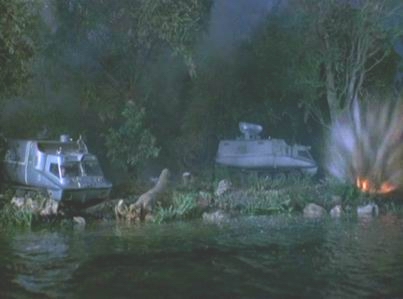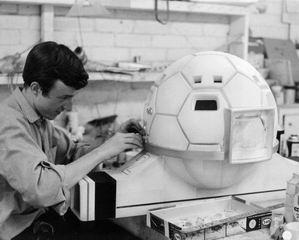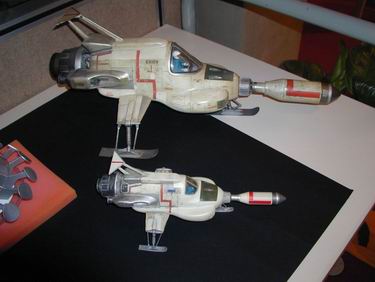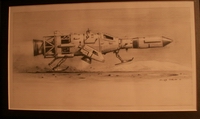MIKE TRIM risponde...
MIKE TRIM answers questions...
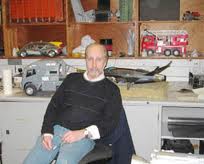 |
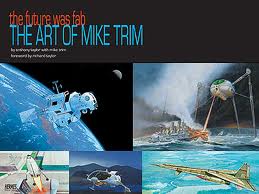 |
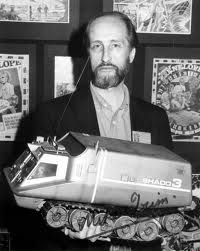 |
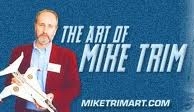 |
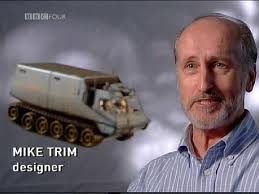 |
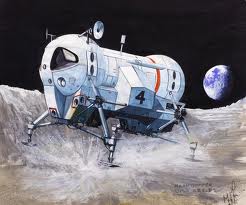 |
 |
In questa pagina abbiamo l'onore di pubblicare una serie di risposte che Mike Trim (Special Effects Designer) ha gentilmente fornito a ISOSHADO a fronte delle nostre domande sugli effetti speciali e sui modelli del set di UFO. Per conservare l'originalità delle parole di Mike, abbiamo scelto di pubblicare le domande in italiano e le risposte in inglese. Per la traduzione potete utilizzare il traduttore di Google.
Chiunque volesse porre domande a Mike sull'aspetto "modellistico" e sugli effetti speciali della serie UFO può inviare una mail a info@isoshado.org
Should you wish to ask any additional question related to models and special effects of UFO, please e-mail info@isoshado.org.
1) Sappiamo che nella serie UFO il modello dello SHADO Mobile era stato realizzato solo nella versione “grande”, cioè poco più corto del Tiger Joe Tank (il carro armato giocattolo da cui erano stati tratti ruote e cingoli). Tempo fa qualcuno ha menzionato però l’esistenza di una seconda versione del modello di dimensioni più ridotte (all’incirca la metà del modello “large”) da usare per le riprese da lunga distanza, così come erano state realizzate versioni in due dimensioni per gli Intercettori, il S.I.D., lo Skydiver ecc… Puoi dirci qualcosa a riguardo? |
|
| 2) Puoi confermarci che esistevano tre diversi formati del modello dello Sky1 (Quello collegato al Diver più piccolo, quello dello Skydiver grande e un terzo modello, ancor più dettagliato per le riprese da distanza ravvicinata, attualmente di proprietà di Phil Rae)? | 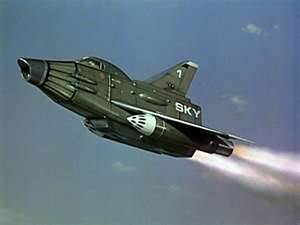 |
3) La mia seconda domanda si riferiva al solo Sky1 e non all’intero Skydiver, quindi quando parli del modello lungo 6 foot credo tu stia parlando dell’intero Skydiver (grande) e non del solo Sky1. |
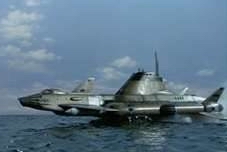 |
| Yes, sorry for the confusion, there were indeed three sizes for Sky 1. The smallest and the middle sized versions were indeed, as you rightly say, part of the tree foot and six foot Skydivers which were the only models of the complete submarine I can remember us having. I also seem to recall a large model of just the Skydiver conning tower built, but I do not know which episode it was for. The third and largest version of Sky 1 was, I am fairly certain, built at 1/12 scale, because I remember David Palmer making the pilot figure for it using one of our standard plastic military figures as the basis. These figures were the same ones that we used in the Shadomobiles, which were of course built to the same scale. |
 |
4) Ci risulta che esistessero due modelli di Base Luna, uno grande e uno più piccolo. |
|
As far as Moonbase is concerned there were two complete models it built. One was at the size shown in the Alan Shubrook photo, which was something around 1/12 scale, while the other in the first photo was probably around 1/24 scale. The largest of these was created to be in scale with the large 3ft model of the Lunar Module, while the smaller version was scaled to go with the 15 or 18 inch model of the spacecraft. There are three very good photos showing the subtle differences between the two sizes reproduced in the large pink cover Japanese book, published many years ago now, covering all the Anderson series.
I also have a vague memory of a much smaller Moonbase model, although I cannot recall specifically why it was built or any particular episode it appeared in. But it would have been done to give us the opportunity to create either an extreme long shot or a very high angle one. One of the photos shown in the book mentioned above shows a high angled shot the small Lunar Model descending towards a Moonbase, but this is the 1/24 scale version and not the third very small model I'm talking about.
5) I modelli dell’Intercettore erano stati prodotti in due scale diverse, uno grande e uno più piccolo. Il primo era molto dettagliato e la cabina di pilotaggio includeva il pilota (il mitragliere del Tiger Joe Tank, lo stesso soldatino usato per la versione grande dello Sky1), ma non è certo se anche l’Intercettore piccolo avesse la cabina di pilotaggio con pilota. Puoi dirci qualcosa in proposito? |
|
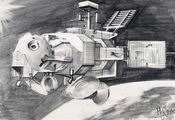 6) Un nostro Socio vorrebbe sapere "come" i modelli originali di studio venivano realizzati.
6) Un nostro Socio vorrebbe sapere "come" i modelli originali di studio venivano realizzati. Questa è una domanda generica e non specifica riguardante un preciso modello, egli spera che tu possa descrivere il completo percorso, dalla tua idea originale a quando il modello era pronto per il set.
Quante persone erano coinvolte nella realizzazione?
Con quali rispettive mansioni?
Designing
As with everything, it starts with the script and from this I would know exactly what the craft or vehicle would have to do in the story. Normally I would begin designing at this stage, although sometimes I would have drawn the storyboards before I started which would have given me a more detailed idea of just what the model would be required to do. The script writer's descriptions of the craft were something I never usually took much notice of, preferring to come up with my own concepts.
The basic design would often be something I came up with fairly quickly, not taking much more than a day at most, and usually by then the rough details were ready to be turned into the final artwork. The form this would take depended on how long I could afford to spend on it. At the beginning of the series, there would be time to do full colour artwork, but as time went on the pressure to get everything done meant that I would probably only create a pencil drawing. I would, however, sometimes produce quick drawings as an aid for the model-makers, like plan and profile outline views, in order to give them information that was not obvious from the main artwork.
Construction
Usually, there was only one model-maker involved in the construction and who that would be was decided by the Senior Model-maker, Ray Brown. I would talk the design through to give that person a reasonable idea of what the model had to do and to give him a chance to ask questions. I would indicate the scale and we would discuss possible construction materials. These depended on how many versions were required or how durable the model needed to be. For one off models like S.I.D or the Lunar Module, this would often be wood, but for multiples such as The Interceptors, Shado Mobiles etc, Fibreglass was more normal.
Once construction was under way, I would usually go over to the model shop at least once a day, if not twice, to see how the model-maker was getting on. This allowed me to make sure that he was getting the look I was after and gave him a chance to raise any problems that had occurred and possible changes needed to solve them.
The model shop were responsible for the basic form of the craft and working items like wheels, lights and suspension, or any moving parts and the means of access inside for batteries, figures or Jetex motors. They would also spray the final colours, although quite often I would ask them to just complete the model finished in grey primer paint. Either way, the next step saw the model transferred to our other workshop.
Finishing
The second model shop, always known as the Dirtying Down Shop, was responsible for the final very important stage before filming. Without it, the models, however finely made, would not look real on screen. Here, they added all the 2D details such as panel lines, lettering, stencil warnings signs, stripes or badges, as well as all the fine modelled 3D etail like pipes, wiring, aerials or complex engine details etc. This was done using paint, pens, coloured tapes, transfers from model kits, together with a lot of pieces from various plastic kits from companies like Airfix, Revell, Tamiya and Aurora.
As with the construction phase, I would visit the workshop every day to again ensure that the finished look was what I was after. If my designing and storyboarding duties allowed, I would frequently work in there as well. In the later stages of Century 21, we found it easier to complete the 3D detailing on a grey primer model and then spray the final colour and apply the 2D detailing afterwards. Sometimes the model would go back to the main workshop to be sprayed, but it was also quite often done in the dirtying down shop itself.
All the team members in both workshops were brilliant at what they did and at creating something that looked right on screen and it was a pleasure to work with them. Without their skills, the designs Derek and I created would not have been as successful as they hopefully were.
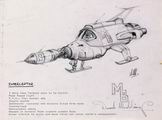 7) In genere, per ciascun modello della serie UFO, noi abbiamo sempre visto pochissimi disegni di pre-produzione.
7) In genere, per ciascun modello della serie UFO, noi abbiamo sempre visto pochissimi disegni di pre-produzione.
Ad esempio, riguardo al Lunar Module e Carrier, conosco solo il tuo blueprint in bianco e nero, attualmente nell'archivio di ISOSHADO, e un grande disegno a colori di Derek Meddings.
Lo stesso per l'Intercettore: ci risultano esistenti solo il tuo disegno del prototipo e la versione finale, ancora di Derek.
Riguardo al SID, si conosce solo il tuo sketch in bianco e nero, così come per il Moon Mobile esiste solo il tuo disegno a colori.
Sostanzialmente ho sempre visto uno, o al massimo due disegni di pre-produzione per ciascun modello.
Erano sufficienti questi pochi "artwork" a dare le istruzioni necessarie ai modellisti su come realizzarli? Oppure esistono altri disegni che non sono mai stati diffusi?
At other times I would sometimes do rough side or plan views to give the model makers a better idea of want we wanted, or a more detailed drawing of some part of the design like that featured on the Lunar module artwork, for example. But most of these were quite scruffy in appearance and were usually thrown away after construction. The main reason any of the artwork still exists is because Derek and I would make a point of rescuing the ones we were particularly happy with from the workshop, were they would normally be found half-buried at the back of a workbench covered in sawdust. But even so, I know that some of it still got thrown away from time to time before we had a chance to retrieve it. Obviously over the years after the demise of Century 21, both Derek and I kept our artwork safely stored away, which is why it still exists.
The thing that facilitated the smooth transition from perhaps just one design drawing to the the finished model was the fact that I made a point of fully briefing the model makers at the beginning of construction and backed this up with daily, or twice daily, visits to the model-shop to ensure that things were going in the right direction. It was also quite usual for me at this time to do little scribbles to help illustrate the points I was making, but of course these were never kept.
There is also one very important aspect to this story that, over the years, I have always made a point of stressing. We were blessed with an exceptionally talented and highly skilled model-making team. They knew the sort of thing we were after and, if they were in any doubt or there were any unforeseen problems, they would come and discuss it with us and that way we were able to, nine times out of ten, end up with pretty much what we wanted.
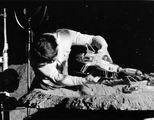 8) Dalle foto dietro le quinte, abbiamo capito come volavano gli Intercettori, o per meglio dire come venivano mossi sul set. C'è però un dettaglio ancora per noi sconosciuto: come era lanciato il missile dell'Intercettore? Tramite dei fili, oppure grazie a una molla? O c'era qualche sorta di piccola esplosione all'interno del modello che provocava un reale lancio del missile?
8) Dalle foto dietro le quinte, abbiamo capito come volavano gli Intercettori, o per meglio dire come venivano mossi sul set. C'è però un dettaglio ancora per noi sconosciuto: come era lanciato il missile dell'Intercettore? Tramite dei fili, oppure grazie a una molla? O c'era qualche sorta di piccola esplosione all'interno del modello che provocava un reale lancio del missile? 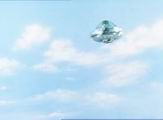 9) Una domanda specifica sul modello dell'UFO: dalle numerose foto in nostro possesso, abbiamo notato molte differenze tra i vari modelli di UFO. Alcuni hanno gli scudi rigati, altri piatti, lo stesso per le braccia che li sorreggono. La domanda principale è: il modello dell'UFO era costruito esattamente in due precise dimensioni (piccola e grande) o vi erano modelli di misura intermedia?
9) Una domanda specifica sul modello dell'UFO: dalle numerose foto in nostro possesso, abbiamo notato molte differenze tra i vari modelli di UFO. Alcuni hanno gli scudi rigati, altri piatti, lo stesso per le braccia che li sorreggono. La domanda principale è: il modello dell'UFO era costruito esattamente in due precise dimensioni (piccola e grande) o vi erano modelli di misura intermedia?Giusto per avere un'idea: quanti modelli, dal primo al ventiseiesimo episodio di UFO, erano stati usati? Ovvero, quanti modelli dell'UFO erano stati costruiti in totale?
As filming went on it was quickly realised that other sizes would be needed to achieve some of the shots and I think there were two more progressively smaller versions made. It also became apparent that, with three shooting stages running at the same time and the need to show several UFO's in shot at one time, there needed to be more than one of each type required. I would think there was probably something like about a dozen all told, but I honestly cannot remember for sure and it could be slightly more than that.
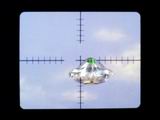 10) Restando sul modello dell'UFO, supponiamo che esso ruotasse grazie a un piccolo motore all'interno del corpo principale; ma come funzionava? Grazie a una batteria interna, o tramite una molla interna e senza motore?
10) Restando sul modello dell'UFO, supponiamo che esso ruotasse grazie a un piccolo motore all'interno del corpo principale; ma come funzionava? Grazie a una batteria interna, o tramite una molla interna e senza motore? 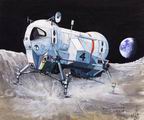 12)
Il disegno del Moon Mobile di UFO è ovviamente simile al Moon Hopper di Captain Scarlet dove il modello “saltava” veramente e in uno dei primi episodi di UFO (Flight Path) il tenente Ellis lo definisce Moon Hopper anziché Moon Mobile. Vi sono altri collegamenti tra i modelli usati in UFO e quelli di altre serie? Vedi relazioni tra l’Angel Interceptor di Captain Scarlet e il Moonbase Interceptor di UFO?
12)
Il disegno del Moon Mobile di UFO è ovviamente simile al Moon Hopper di Captain Scarlet dove il modello “saltava” veramente e in uno dei primi episodi di UFO (Flight Path) il tenente Ellis lo definisce Moon Hopper anziché Moon Mobile. Vi sono altri collegamenti tra i modelli usati in UFO e quelli di altre serie? Vedi relazioni tra l’Angel Interceptor di Captain Scarlet e il Moonbase Interceptor di UFO? As you may know I was appalled to learn that Gerry loved my design for the Scarlet Moon Hopper and wanted to have it in UFO, which is why perhaps it was mentioned in that very early episode. However, I was determined to create an updated version which would hopefully look far more realistic, especially as it was going to be one of the main craft, and make it look as if the technology behind it was linked to others in the series like SID and Moonbase.
I certainly didn't want it hopping because, not only did it look very comical, it also created problems when it came to filming, especially when we needed to feature the model travelling across what were by now quite large lunar sets built on the studio floor. A non-hopping craft could be suspended from a strong wire that spanned the set and simply pulled along it. But if it was going to hop then it would have to hand flown, which would require someone to virtually run along a series of narrow boards erected above the set, lifting and lowering the model as they went. Because we usually filmed at high speed this would need to have been done reasonably fast which would not only be dangerous for the operator, but extremely difficult to do without breaking the legs of the model as it bounced across the set. Also, the amount of time needed to construct the boards etc would have not been practical and the Moonmobiles would not have been able to get to their destination with any great speed. So we ended up with the more realistic hovering version you all know and I'm pleased to say that Gerry was very happy with my changes.
As for there being any links between models from different series, the answer is not really. I certainly don't recall having done this for the following reasons. Each design was based on the requirements of the script and the constraints of time and ease of manufacture. Therefore, what might have worked for a Scarlet story was unlikely to work for a UFO episode, as the stories were so different. Also, as a designer, I always wanted to come up with something new rather than rework an existing concept and, had Gerry not brought up the idea of using the Moon Hopper, then the design of the Moommobile would probably have turned out to be quite different. As for possible similarities between the Angle Interceptor and the UFO version, again there were none. Derek Meddings designed the Scarlet one as a fairly conventional aircraft, where as I came up with what was a pure spacecraft concept which Derek then reworked into the final version. The fact that both craft featured skis is purely coincidental, as in both cases this was the most appropriate and logical form of landing gear given how the craft operated.
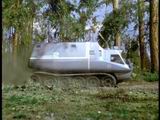 13)
I modelli più famosi della serie (Intercettori, Shadomobili, Sky1 e Skydiver, Lunamobili, UFO etc.) furono costruiti prima dell’inizio delle riprese oppure la loro realizzazione avvenne contemporaneamente alle riprese?
13)
I modelli più famosi della serie (Intercettori, Shadomobili, Sky1 e Skydiver, Lunamobili, UFO etc.) furono costruiti prima dell’inizio delle riprese oppure la loro realizzazione avvenne contemporaneamente alle riprese? As far as I can recall most of the major models were either completed or well advanced before we started filming. Obviously, those required for the first episode would have been the priority, but I can't remember if all of the craft mentioned in your question were included in that particular story. I imagine that, as it was the pilot episode, they would have been required in order to establish what SHADO was all about and how it functioned.
However, after all this time it is difficult to recall how many of the different sized versions of the various models were constructed for that first show. It was often the case on previous series, that the need for a variety of sizes of some models was something that came from experience as filming went on. Certain shots would have been difficult without the addition of a larger or smaller model. It is quite possible that this was also true for UFO. Certainly the Interceptors were built at 1/12th scale, along with the launch bay, but whether we also had the 1/24th scale versions when we shot the pilot, I'm not certain. I know that we already had the 1/24th scale version of Skydiver when we built the 1/12th model, but whether that was at the start of filming or some time later, again, I'm afraid I'm not at all sure.
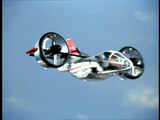 14)
C'era un modello che hai trovato molto facile e veloce da costruire rispetto ad un altro modello che ha richiesto più del tempo previsto per la sua realizzazione?
14)
C'era un modello che hai trovato molto facile e veloce da costruire rispetto ad un altro modello che ha richiesto più del tempo previsto per la sua realizzazione? Over my six years at Century 21 there were, I am sure, many models that were quick and easy to come up with and many that proved much harder to create. Sadly, after all this time it is difficult to always recall what the details are, especially when linking this to just one particular series.
Certainly, one of the hardest on UFO was the UFO itself. What I didn't want to come up with was the rather tired and corny concept of a flying saucer, especially as this had been used so many times before in other films. I wanted something that was completely different and original. However, I found it very hard to design something that would work in the context of what was scripted, where we obviously had to have some form of craft that would look right being pursued in space and the earth's atmosphere. Derek, on the other hand, favoured the more conventional 'saucer' approach and so, slowly, we headed in that direction. I was still determined to try and make the thing look different and give it a distinct shape of its own, rather than something that looked like a car hub-cap. So, with Derek's occasional input, it gradually evolved into the final concept, it's form defined to some degree by the way in which it had to operate and fly, with its transparent outer shell and rotating inner core, as well as the requirements of how it was to be made. I was never that happy with the end result and would love to have had more time to refine the design, but the tight schedule, and the probability that we would have to produce several models at a variety of sizes, simply did not gives us that luxury.
By contrast, the SHADO Tilt-Fan aircraft was something I designed very quickly, probably within a couple of hours of first seeing the script. What actually took the time was building the model.
Earlier aircraft models were usually carved from wood and had clear cockpit canopies added.
Often, these didn't fit that well and had rather obvious gaps where they joined the fuselage.
Given that the design featured very large areas of glazing, in order to avoid this problem I decided that the body should be made it two halves, split down the centreline, and moulded in clear perspex. That way we could simply mask out the windows when spraying the body colours and lines representing where the cockpit would open, could be neatly drawn on using a biro pen
In the skilful hands of model-maker Charlie Bryant the final craft was superbly built, as I knew it would be. It was exactly as I had conceived it in my mind. Much to my dismay, however, having spent a lot of time on it because I believed it would be a much used craft, it only ever featured in one episode. Had I been a dishonest person and decided to keep a few of the models for myself when the studio closed down, the Tilt-Fan aircraft would definitely been one of them.
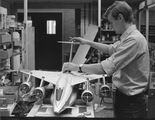 15)
Hai menzionato il fatto che molti modelli furono autocostruiti sulla base dei disegni originali e poi eventualmente arricchiti con parti provenienti da scatole di montaggio. Ti ricordi quali modelli furono sostanzialmente realizzati da zero e quali invece furono prodotti utilizzando in maggior parte pezzi provenienti da scatole di montaggio?
15)
Hai menzionato il fatto che molti modelli furono autocostruiti sulla base dei disegni originali e poi eventualmente arricchiti con parti provenienti da scatole di montaggio. Ti ricordi quali modelli furono sostanzialmente realizzati da zero e quali invece furono prodotti utilizzando in maggior parte pezzi provenienti da scatole di montaggio? The main craft for all the series where always created from scratch and normally the principle craft or vehicle for a particular episode was also produced in this way. The use of kit parts on these was usually fairly limited and employed to gives small areas of detail. In the earlier series, such as Thunderbirds, the secondary or supporting craft were sometimes built from kit parts and other found objects, but as the various series progressed, however, this tended to become less frequently used and even these craft would be scratch built.
By the time we got to UFO, nearly all such models were built in the model workshop and then detailed with kit part if necessary. There were exceptions to this, however. I remember Dave Palmer from the dirtying down team and myself creating a spacecraft for one of the episodes, who's basic form was created from household items like plastic bowls and cake boxes. We even used the spherical float from a flush toilet cistern for the crew module at the front, then the whole thing was heavily detailed using plastic kit parts. There was also a small base on the moon created for one episode which was completely built from gubbins and kit parts and I remember building a small craft sitting alongside it, made from a plastic kitchen storage container, some ping-pong balls and detailed with kits bits.
On page 124 of Derek Meddings 21st Century Visions book, there is a photo on the top left hand page of a probe in orbit above the Moon which is a completely kit and gubbins built model created again by Dave Palmer. And on page 335 of the large Japanese pink book on the Anderson series, there are two photos of a another space vehicle created in the way. In both cases I had designed these models on paper and then left it to the model-maker's ingenuity to interpret this in their own way. I'm glad to say that in both instances, the end result was very close to my original concept.
The main way completely kit built models appear in UFO is as part of the background dressing such as aerial towers, antennas, cranes or small vehicles at airports. I am sure there are other examples, but without sitting through every episode, it is impossible to recall them.
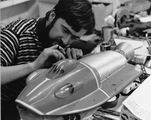 16) Ecco una ulteriore “doppia” domanda per te:
16) Ecco una ulteriore “doppia” domanda per te:1- la preparazione degli stampi richiedeva molto tempo? Una volta pronto lo stampo, quanto tempo era richiesto per la realizzazione del modello? Tutti i modelli erano realizzati in resina oppure anche in altri materiali per esempio in legno?
2- anche le piattaforme di lancio degli Intercettori furono realizzate dal tuo staff di modellisti? Come avveniva il sollevamento delle piattaforme?
The short answer is that it depended entirely on how complex the particular model was and how big. I would think for something like the large I/12 scale Interceptors you would probably be looking at about two or three weeks, for carving the wooden pattern, making the moulds and casting the fibreglass pieces, assembly and finishing, then painting and final detailing. With the large Skydiver it was probably a bit longer, although there may have been more than one model maker involved which would have obviously shortened the time. On average the final detailing and dirtying down etc, would only probably take two or three days.
The decision as to whether to cast any particular model was usually driven by a number of factors.
Firstly, was more than one model need as in the case of the Interceptors and Mobiles? And secondly there was the question of weight. A six-foot long Skydiver all carved from wood would have weighed a great deal and would have been very difficult to hang on wires. Thirdly, was this model just going to appear in a single episode or did it have to last for the entire series.
Fibreglass models were less vulnerable to damage than ones made of wood - especially balsa wood as was sometimes used to create a very light model. Sometimes though, as in the case of the Lunar Module, even a model that would go right through the series would still be carved from wood, simply because there was only one needed of each scale. And the last factor would time considerations. Obviously, when making moulds for casting, you have to carve the model in the first place so, if time is short, it is quicker and easier to simply finish and use that wooden version.
With regard to the Interceptor launch bays, I did a quick design the was constructed in the model shop and I, and the crew in the dirtying down shop, detailed it. If my memory is correct, the lifting of the platforms was achieved by using the camera dolly under the set, with a pole going up to the platform. By its very nature, the dolly was able to give us a very smooth up and down movement.
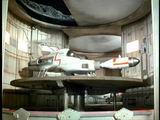 17)
Abbiamo notato che le piattaforme di lancio degli Intercettori furono realizzate utilizzando scatole metalliche di bobine di pellicole 35mm: ti ricordi di questo dettaglio?
17)
Abbiamo notato che le piattaforme di lancio degli Intercettori furono realizzate utilizzando scatole metalliche di bobine di pellicole 35mm: ti ricordi di questo dettaglio?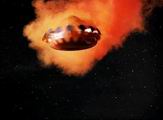 18) Il modello dell’UFO dispone di una serie di scudetti argento: è vero che erano posizionati in maniera irregolare attorno al modello per generare l’ondeggiamento durante la rotazione?
18) Il modello dell’UFO dispone di una serie di scudetti argento: è vero che erano posizionati in maniera irregolare attorno al modello per generare l’ondeggiamento durante la rotazione?Vediamo inoltre numerose sequenze di UFO che esplodono: avevate predisposto due differenti modelli dell’UFO, uno dettagliato per le riprese e altri meno dettagliati per le esplosioni?
The silver shields, or paddles, were originally placed all the same way - I think with the points facing upwards. But with this arrangement it was hard to see the thing was rotating at all. So Derek decided we should position them alternatively up and down to give a better impression of the spin. However, if I remember correctly, the number of paddles on some of the models could not be divided by two to give an equal number of each position, which led to there being an uneven arrangement of two paddles both of which ended up pointing the same way. This had an unexpected advantage, I seem to remember, of adding to the impression of rotation. I can't recall whether this was the case on all sizes of model.
I am really not sure what happened when we needed to blow up a UFO because of the fact that they needed to rotate, which obviously required an internal motor which would have possibly been damaged in the explosion. It is possible that we used a process known as a 'jump cut', where the normal model would have been removed and an explosive charge put in it's place. The explosion would then have been edited into the UFO shot and the result would have looked convincing. As Ian Wingrove is visiting you, and would most likely have been involved in many such shots, he would be perhaps be able to shed more light on this particular question.
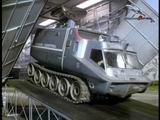 19)
19) 1- Ancora sulla rotazione del modello dell’UFO: in Computer Affair un UFO emerge dalle profondità di un lago roteando: si trattava di un modello speciale fatto per funzionare in acqua?
2- Gli Shadomobili funzionavano tramite un motore o qualcuno li muoveva tirando dei fili?
3- Hai supervisionato o creato le armi da fuoco usate nella serie?
I have to admit that, without being able to watch the sequence of the UFO emerging from the water, I am not at all sure as to how these shots were achieved and again, this might be a good question for Ian Wingrove. I can, however, offer a possible suggestion. It might be the case that the UFO was not in the water at all, but down behind the back edge of the water tank, with an explosive charge in the water in front of it to give the impression of it bursting out. Given the very low camera angles we used, I can recall other occasions when similar tricks were used and I cannot see how we could have put the model in the water and still used its motor to spin it. I shall be interested to see if Ian can give you a definitive answer on this.
The Shado Mobiles were always pulled on wires, as were all the other vehicles, and had no motors fitted to them. It has to be remembered that radio controlled models were few and far between in those days and the reliability of such systems was far from perfect, so we never used them. Also, given the different camera speeds that were used for the various shots, it was far easier for an operator pulling a wire to vary the speed at which the model had to travel. By the time UFO was filmed, the special effects crews had had a great deal of experience using wires and Derek Meddings was very loathed to put his faith in an alternative method. Another factor that would have made radio controlled Mobiles impossible, apart from the lack of the necessary equipment, was the weight of the models. In order to get their suspensions riding smoothly over rough ground they usually had a considerable amount of weight added to stop them bouncing about and it would have been difficult to obtain electric motors with sufficient power that would fit into what were quite small models and propel them at the sort of speeds demanded during filming.
On this last question I am not sure which special weapons the questioner is referring to, so perhaps they could give me some more details on this and I will do my best to answer. Anyway, I hope these responses will be of interest and I look forward to receiving this expanded question.
1) come era prodotto il suono dell’UFO?
2) un fan chiede: mi sono sempre domandato quale fosse la fonte di ispirazione del meraviglioso design delle auto della SHADO, del look futuristico degli intercettori, degli Shado Mobili e degli UFO, dello strepitoso look delle ragazze di Base Luna.
As far as my involvement in the design of the weapons goes, the only one I was responsible for was a shoulder mounted rocket launcher fired at a UFO flying low over the Lunar surface by, I think, the actor George Cole - was that the Molly Bazooka? Not knowing if this would be just a one off or if the weapon might appear in other episodes, and also if more than one might be required, I designed it to be easily constructed. To achieve this I used components from a range of plastic water pipes, which formed the bulk of it, and a cheap hand-held 35mm slide viewer to act as the sighting display. This then only required the thing to be assembled, some way of attaching the sight to be made and the whole thing sprayed, all of which could be done fairly quickly. The pipe itself also gave the SFX technician plenty of room to install their charges and, from what I can recall, the whole thing work pretty well.
As to the first new question I'm afraid I don't know the answer, having never had any real contact with the technicians that did the sound effects. As far as I know it was all done by an outside company, but again I have no idea who or where they were.
As far as the source of our inspiration is concerned, I suppose there where several things that formed this. Firstly, both Derek and I were aware of the technological developments going on at the time and, as I've often said before, our natural style was to design for the near, rather than far, future. Therefore we would try and come up with something that was more futuristic, but which was not so outlandishly different to the things we were all familiar with.
Secondly, from my own point of view, what the script required a craft or vehicle to do in the story was certainly a very strong factor in shaping the final appearance of a design. The script writers had, thankfully, long ago given up writing descriptions of them, but things like the sort of terrain they would be operating in, the number of crew they carried, what sort of armaments they had and the size they needed to be would all help shape the final concept. Sometimes the practical requirements of building and operating the models could also influence the design and ignoring this and simply going for the look of the thing in order to try and make it look different, as I did with the Russian Lunar Drilling Rig wheels, can cause significant problems in both areas.
As for the look of the Moonbase girls well, Derek and I can take no credit there, I'm afraid. That was all down to Mother Nature and the skills of the wardrobe, hair and make-up departments!
| 21) Un collezionista mi ha offerto un oggetto di studio presumibilmente originale: si tratta della sfera di controllo della versione piccola del SID. Ritengo al 99% che sia originale, ma gradirei conoscere la tua opinione a riguardo. | 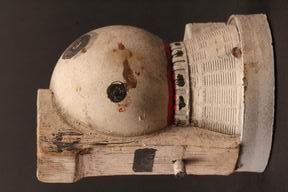 |
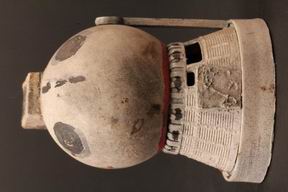 |
With regard to the SID image, I'm assuming this is the remains of the small model of SID, judging by the size of the wood grain and the sort pieces it is constructed from. Obviously, for a model that was intended for use only as a long shot the details did not have to exactly match the larger version, but just give an convincing impression.
Therefore it would have been made up from a lot of bits and pieces that would not have withstood too closer scrutiny.
However, it is a very long time since I last saw the model and I cannot recall ever studying it closely enough to have made a note of how it was constructed.
I hope you can manage to negotiate a reasonable price for it.
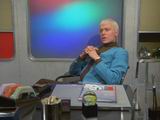 22) Un fan ci scrive: la mia domanda riguarda il pannello colorato alle spalle della scrivania nell’ufficio di Straker, che ho sempre ammirato sin da ragazzo e che vorrei provare a riprodurre. Questo è ciò che io suppongo:
22) Un fan ci scrive: la mia domanda riguarda il pannello colorato alle spalle della scrivania nell’ufficio di Straker, che ho sempre ammirato sin da ragazzo e che vorrei provare a riprodurre. Questo è ciò che io suppongo: - il pannello è in vetro o plexiglas semitrasparente;
- il pannello è retroilluminato;
- dietro al pannello è collocata una specie di lente che proietta i colori, montata su un supporto circolare che ruota grazie ad un motore elettrico.
 23)
Se si guarda un UFO dall’alto, lo spazio utile per i passeggeri è molto piccolo. Calcolando le dimensioni reali (grazie all’episodio ESP dove si raffronta l’UFO con la casa di Croxley e all’episodio Flight Path dove l’UFO sorvola da vicino l’auto di Roper) esse dovrebbero risultare altezza 4 metri e diametro 5 o 6 metri. La mia domanda è: riesci a descrivere l’interno dell’UFO che dovrebbe contenere due Alieni, un contenitore per il corpo dell’umano rapito e spiegare come potrebbero sopravvivere gli occupanti durante la rotazione dell’UFO?
23)
Se si guarda un UFO dall’alto, lo spazio utile per i passeggeri è molto piccolo. Calcolando le dimensioni reali (grazie all’episodio ESP dove si raffronta l’UFO con la casa di Croxley e all’episodio Flight Path dove l’UFO sorvola da vicino l’auto di Roper) esse dovrebbero risultare altezza 4 metri e diametro 5 o 6 metri. La mia domanda è: riesci a descrivere l’interno dell’UFO che dovrebbe contenere due Alieni, un contenitore per il corpo dell’umano rapito e spiegare come potrebbero sopravvivere gli occupanti durante la rotazione dell’UFO? This is a very interesting question. I think it is a classic example of one of the problems faced when designing this sort of concept. Do you concentrate purely on the look of the thing, trying to create something that will work well on screen, as well as being practical to make and operate? Or do you begin by approaching the problem as if you were designing a real machine and make it accommodate all the things that it would have to fit inside it?
Obviously you are doing this right at the start of a production and, at that time, the only thing you have to work on is the pilot script and I can't remember whether the aliens themselves were featured in that, but I suspect not - therefore, they would never have featured in our thinking. We were far more concerned with the external appearance of the UFO and how we were going to fly and spin it, as well as how we were going to make it and produce it in different sizes.
By the time the later scripts introduced the aliens, it was too late to worry about how practical it was for aliens to be inside. The fact that you have been able to come up with a scale for a UFO is purely down to two random factors. Firstly, all of our vehicles and buildings, such as the house in ESP, were built to a common one twelfth scale throughout the series. Secondly, the large UFO's size was dictated by the fact that we had to manufacture the clear perspex outer shell in house and that was the largest we could produce without having to involve an outside firm, which would have been costly and time consuming. So when it became necessary to show both models in one shot, it was not possible to create a larger version of the craft. And, to be truthful, I don't think it would have occurred to either Derek or myself that someone in the future would be working out the relative measurements.
So, in the end, I think it simply comes down to this. In a series of this nature, produce for television with strict schedules tied into transmission dates, there simply is not the time to design everything in detail or to make lots of different sized models as you might on a film. Also, on a film, you just have one script so you know from the start what a craft has to do and you do not get different script writers introducing fresh ideas as you go along.
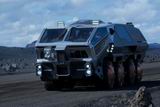 24) Alcune domande da Paolo Brandimarte.
24) Alcune domande da Paolo Brandimarte. 1) I modelli in UFO erano arricchiti con dettagli e parti provenienti da scatole di montaggio come l’Honest John della UPC. Come avveniva la selezione delle scatole di montaggio da cui trarre i pezzi? C’era qualcuno addetto nello specifico a questa selezione? Avevi una chiara idea dei pezzi da utilizzare o si trattava di una scelta casuale (scelta oltretutto limitata dato che utilizzavate sempre le stesse scatole di montaggio).
2) I modelli usati in Captain Scarlet sono stati più o meno aggiornati per la recente versione della serie in computer grafica. Se dovessi realizzare un versione CGI di UFO, manterresti lo stesso design dei modelli della serie o preferiresti modificarli?
3) Questa immagine è tratta del recente film Prometheus. Trovi delle analogie con lo Shado Mobile? Potrebbe qualcosa del genere essere lo Shado Mobile per una ipotetica nuova serie di UFO o un film?
As the various series that proceeded UFO went on we did, by trial and error, gradually narrow down the kits we bought and settled on a standard selection which we knew would give us really interesting well moulded detailed pieces. Many of these came from companies like Revell, Aurora and Tamiya and we bought them in reasonably large quantities. The boxes were discarded, the parts removed from the sprue and then put into large shallow trays that made sorting through them far easier and quicker. Alongside this selection we would also order large boxes of kits from Airfix, as we had from the days of Thunderbirds, of things like the girder bridge, footbridge and signal gantry, as well as the B29 Superfortress. Normally it would be the boys in the dirtying down workshop who would order these and, when something new and interesting came on the market, would dash off to the local model shop to get one.
Your second question is a more difficult one to answer. One thing is certain; if I were creating an updated series then the look of things would certain change, because the originals were very much a product of their time. The difficult thing to do, however, is to try and imagine exactly what changes one would make without spending a lot of time drawing up new ideas. When designing I very rarely start off with a clear image in my mind of what I want something to look like. Normally, I just start drawing and developing the idea until I get a basic concept. Once I have that I can then begin to refine it towards the finished idea. Sadly, without going through that process first, I'm not sure I can come up with a satisfactory answer.
As for the photo, yes, I can see some similarities with the Shadomobile, aided I think by virtually the same colour being used. Were a new UFO series being considered then something like this might work, although I find the design a little over complex and fussy. But that is probably because my style is different.
| 25) Il tuo disegno iniziale dell’Intercettore era molto più “spaziale” e simile ad un razzo del modello che si vede in UFO. Ti è stato chiesto di modificare il concetto originale del velivolo, e se sì perché? Da quale velivolo hai preso ispirazione per disegnare lo Sky 1? C'è poi una curiosità: dov'è lo scarico del turbogetto che si sente nel telefilm? I lanciarazzi alari fanno anche da razzo per il decollo sott'acqua, ma poi, il motore per il volo atmosferico dove si trova, visto che oltretutto c'è la presa d'aria sul muso? |
|
The reason that the original Interceptor design and the version that appeared in the shows are different is that they are not both my designs.
When my boss Derek Meddings saw my concept he felt it did not look futuristic enough, although he had been perfectly happy with my designs for S.I.D, Moonbase and the Moonmobile, all of which I felt had the same sort of look. I had created them to look as they were all designed and constructed using the same approach and technology. He therefore chose to come up with his own smaller version which kept the same overall layout as my original, but streamlined it which, given the complete absence of any atmosphere on the moon or in space, was completely unnecessary. He also ended up with a model which had less detail, like the exposed engine area and swivelling side pods that contained the vertical thrust engines on the original, which I always felt was a shame. I had also intended that the exterior cockpit area of my design was simple enough to have easily been built as a live-action set, whereas there was, if my memory is correct, no such set ever created by the art department probably because of the more complex shape in Derek's design. I am obviously biased here, but I do wish my design had been the final one selected. However, Derek was in charge and he obviously had the final word.
Once again, Skydiver was designed by Derek and therefore I can only offer my opinion on this question, rather than give you a definitive answer. Like you I was somewhat puzzled by the design of Sky1. It seemed very odd to have a nose intake on a craft that went underwater, especially as it had to accelerate up and out of the water in order to take off. And although I don't think we ever saw it land on water again, one had to assume that it did and so that intake would have again been impractical - if not extremely dangerous! Before I was aware that he had started work on the Skydiver concept, I had begun to draw my own and therefore I know had difficult it was to overcome all of these problems.
I can only assume that Derek did not spend too much time analysing how this craft might work in reality when he designed it and simple went for the overall look of the thing. Most designer have what might be called their trademark and intakes certainly were something that featured a lot in his designs. Even back in the days of Thunderbirds he gave another submarine, Thunderbird 4, lots of intakes, so perhaps it is not surprising that one turned up on Sky1!
If we assume that the intake fed air to some sort of jet engine located in the fuselage there should, as you suggest, be jet nozzles at the rear of the craft and it is clear that there were not, as the flat rear end contained the door from the body of Skydiver itself, together with various connections between the two parts of the craft. So exactly how the propulsion system for airborne flight works, I'm afraid I don't know.
All I can say in Derek's defence is that, when designing right at the start of a series, it is not always possible to come up with a something that not only looks good on screen, but is also an entirely practical concept. Sometimes tight preproduction schedules simply do not allow you that luxury.
 26) Con riferimento ai principali modelli di UFO (Skydiver, Sky 1, Interceptors, Shado Mobiles, SID, Moonbase), cosa sarebbe stato possibile migliorare? Cosa pensi fosse sbagliato e cosa avresti realizzato diversamente? Quali modifiche avresti voluto apportare, col senno di poi (inutile dire che, per noi fan di UFO, tutti i modelli erano perfetti così come apparivano in TV)?
26) Con riferimento ai principali modelli di UFO (Skydiver, Sky 1, Interceptors, Shado Mobiles, SID, Moonbase), cosa sarebbe stato possibile migliorare? Cosa pensi fosse sbagliato e cosa avresti realizzato diversamente? Quali modifiche avresti voluto apportare, col senno di poi (inutile dire che, per noi fan di UFO, tutti i modelli erano perfetti così come apparivano in TV)? It is always difficult to answer a question like this without sounding overly critical of what has gone before and, in my case, also being critical of somebody else's designs. However, this is an extremely interesting question so I will do my best on a case by case basis.
SKYDIVER . I think I would redesign Sky 1 in order to overcome the problems identified by your previous questioner and also to try and make the main body of Skydiver somewhat less conventionally submarine like. I would probably give it a wider more elliptical section, with a shorter, longer and more streamlined conning tower.
INTERCEPTOR . At the risk of sounding very egotistical, I would go back to my original design and rework it, in order to keep the same basic layout, but with one or two differences. I would increase the size of the side pods to look as if they could accommodate a more powerful engine arrangement, with perhaps two large jet nozzles underneath. And, although I'm not exactly sure what I would do with it, I would certainly change the one missile armament to accommodate a number of smaller, but equally powerful weapons.
SHADO MOBILE . I would certainly make them bigger, giving them more height and length, as they were never big enough to contain everything they were eventually supposed to hold. I would also give the cab a more streamlined appearance. I always wanted to have the windscreen sloping more, but was originally limited in doing this by constraints on the full sized set. I would also increase the amount of surface detailing at the rear of the vehicle to included grilled vents, to get rid of heat from the engines, and perhaps some small windows high up on the sides to give some daylight inside. I would replace the now rather old-fashioned looking exhaust with something larger and more impressive looking on both sides of the vehicle. I would also have fitted some form of permanent missile launchers on a turntable base mounted on the rear of the roof, as well as redesigning the large intake grill above and behind the cab and perhaps replace it with two slatted openings, one on each side. It would also be great to be able to redesign the interior in order to make it reflect what else had to be accommodated inside the vehicle and give it a much more hi-tec look.
S.I.D . Whilst keeping the same basic layout, I would redesign the rear section to make it look as if it had been assembled with components flown up from Earth, rather in the fashion of the International Space Station. I would also add a lot more external 'gubbins' to add to this bolted together look - more boxes and cylinders, together with pipes and wiring. I would certainly get rid of the rotating aerials and the slatted rear array, add more detail to the large communication dishes and replace the solar panels with something more modern. I was never happy with them in 1969, but we were hampered by time and a limit on the right sort of materials available then, so I would certainly want something that looked like it had extended, was much longer and hopefully made of some sort of thin gold coloured material - again like the space station.
MOONBASE . I would probably keep the idea of the separate spheres and the linking walkways, but again I think there needs to be more detail on them - some evidence of the vital life support systems that may have sat outside of the living areas themselves. I would also add a lot more in the way of communications dishes etc, but the one big change I would make would be to locate the Landing pad away from the base itself, as I had originally intended. The idea of having a fuel-laden Lunar Module landing and taking off so close just seemed mad to me and a transport system to and from a more distant launch pad would have added to the complexity of the base, as well as giving some quite interesting shots.
I modelli furono realizzati prima dell’inizio delle riprese degli episodi o venivano costruiti durante la realizzazione della serie?
Numerose sequenze erano generiche e sono state utilizzate più volte durante la serie, ma altre sono estremamente specifiche: quando venivano realizzate sequenze di modelli, specificamente per un episodio, che genere di supporto vi era stato fornito? Avevate accesso all’intero copione dell’episodio, o avevate solo alcune note? Quanto tempo vi era concesso per produrre quella sequenza?
Per le sequenze generiche: le filmavate in anticipo nell’ottica di un utilizzo futuro? Come controllavate il risultato finale? Potevate vedere il girato alla fine della giornata?
Accidents with models during filming were not unknown, although the film crews tried to take reasonable precautions to prevent this. Flying shots were the things that perhaps created the greatest number of problems, because the very thin tungsten wire on which we flew models did break at times and there was no easy way one could stop a model dropping onto the set or, worse still, onto the studio floor.
By the time we were making UFO we had set up a proper model store and the idea was that, once the film crew had finished with a model, it would go back to the store to be checked over for damage. The models would be cleaned and got ready for filming next time and, if there was any damage it would be repaired. If the model was very badly damaged it would go back to the model shop to be repaired.
Only the main models that would appear throughout the series would be constructed prior to the start of filming. All the rest would be built as we went along to meet each script's requirements. All crew members would get a copy of the script and I would distribute a copy of all the storyboards to the film crews and both workshops. I would liaise with the live action art department whenever this was necessary. It is very difficult to say how long it took to all of this, but normally we had about three months preparation at the beginning of the series and worked on a two week schedule for each episode. Needless to say we sometimes overran this target!
The generic sequences mainly came from the fact that the first episode ever introduced the audience to all the relevant parts of SHADO and all the main craft launch sequences etc. These became basis of what were known as library shots for use in the subsequent episodes. Sometimes, as we shot those episodes, the decision would be made to save other potential useful shots for the library as well. Every morning the whole film and model-making team would have the opportunity to view black and white rushes of the previous day's filming to establish whether any re-takes were required - hopefully before any major set was broken up.
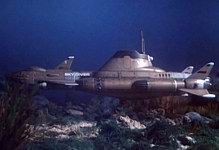 28) Alcune altre domande:
28) Alcune altre domande:
1) In molti episodi vediamo i modelli sul mare o in situazioni sottomarine: i modelli galleggiavano veramente sull’acqua o erano immersi nell’acqua oppure avevate posto una vasca contenente acqua tra la camera da presa e i modelli? (ci sono alcune foto nelle quali possiamo vedere anche dei pesci).
2) In alcuni episodi, vediamo dell’acqua che “bolle” a seguito di un ammaraggio dell’UFO: come ottenevate quell’effetto?
3) Nell’episodio Sub-Smash vi sono molti modelli adagiati sul fondo del mare: come erano state filmate queste sequenze?
All our underwater scenes were usually shot with a dry set filmed through a large, but thin, glass water tank, which did indeed contain some very small fish. An air line was also often added to this tank to create a gentle stream of bubbles. The only times the models ever actually got wet was when they were in our main water tank. Because of this we had to be slightly carefully about what kind of dressing we used on such models as they were quite likely to have to sit in water for some time during the preparation for a shot. Things like tapes had to be used sparingly and probably only on those bits of the model that were likely to remain reasonably dry for most of the time.
As for your second question I think this was probably done using compressed air to create a bubbling effect and may have had a chemical, which was known as TTC, applied to the surface of the water to give an impression of steam.
I'm not sure, but I think your third question has the same answer as the first. If it does not and the questioner is after some additional details then please let me know.
 29) Domande su esplosioni, set e modelli:
29) Domande su esplosioni, set e modelli:
1) In UFO vediamo numerose esplosioni: come erano realizzate? Si sono verificate situazioni pericolose? Ricordi qualche incidente?
2) Ti ricordi quanti set erano utilizzati per filmare le scene con i modelli? (Set lunare, vasca d’acqua per lo Skydiver, boschi, strade per i modelli in scala delle automobili, cieli). Questi set erano mantenuti montati e pronti all’uso o continuamente montati e smontati? O, forse, i set generici erano sempre pronti mentre quelli specifici venivano realizzati per le necessità di uno specifico episodio?
3) In UFO vediamo un’impressionante quantità di modelli, mentre nelle recenti serie TV si vedono sempre gli stessi modelli, in maniera ripetitiva. Può essere dovuto al fatto che la CGI comporta difficoltà/costi diversi rispetto alla produzione modellistica tradizionale?
Many thanks for your latest questions.
!/ All the explosions were usually produced using a small explosive charge, around which was packed a lot of fine powder-paint, of various colours to suit the set, all of which was wrapped in polythene. A small detonator was used to set the charge off - the explosive provided the flash and flame and the powder paint the smoke and dust. Obviously even small quantities of explosive powder can be dangerous and cause injuries, so therefore they had to be handled with care. There probably were a few minor accidents over the years, but as far as I know nobody was ever seriously hurt.
2/ It has to be remembered that the Century 21 premises were not a purpose built film studio. At the time of filming UFO, it consisted of three small identical factory units all of which were occupied by the special effects department. The filming stages themselves were also very small by normal film industry standards which meant that we did not have the ability to leave sets permanently erected, not store large scale sets. The only exception to this was the water tank.
On the lunar set for example the only permanent part of it was Moonbase itself and that was made as a series of separate components assembled on stage. The lunar landscape was built on the studio floor, using sand and polystyrene rocks, and the whole thing was then dusted with powder colour. The reason why we used the floor to build on was because the studio buildings were very low and we wanted to obtain maximum height for our sky backings so that we could doing wide angle shots without seeing the top of backing and film lights above. The camera was placed in a pit dug in the floor. Once all the sequences had been shot, the whole set was dismantled, the rocks and Moonbase returned the store and the sand swept up.
If the next set was a country road the process was repeated. The road sections would be laid down, sand and grass matting would be combined with polystyrene for the hills, individual trees and bushes of various scales would be added and again powder colour would be used to create the final effect. Once all the shots were complete, then the set was dismantled. Although this probably sounds like a very complex and time consuming way of doing things, this method did in fact make things a lot easier and the film crews became extremely good at constructing these kind of sets very quickly. However, smaller sets like the interior of the Interceptor launch bay were built and stored as complete models.
3/ Yes, I think that is probably correct. We were able to very rapidly provide different sets for each episode, sometimes creating them from new and at other times by adapting and redressing an existing set. I have never been involved in the creation of any CGI shots, but I get the impression that the whole process is a lot more involved and requires a far greater degree of forward planning than ours ever did. We had the flexibility to adapt to changing situations, with often no more that a quick discussion and sketch involved in coming to a decision about what, and how we were going to do something. I don't think it's quite that easy with CGI!
Inoltre, i due modelli di Base Luna erano fissi sul set per tutto il tempo necessario per la realizzazione della serie o venivano spostati?
Se si confrontano i due modelli di Base Luna, si notano alcune differenze principalmente nella collocazione delle finestre: qualcuno si è mai lamentato di tali differenze durante la realizzazione della serie?
Per quanto riguarda le scene che prevedevano esplosioni accanto a Base Luna, i modelli erano effettivamente a rischio di danneggiamento?
Come erano realizzate le sequenze di decollo e allunaggio del Lunar Module? E come era ottenuto l'effetto della polvere che si solleva durante l'allunaggio? E durante il decollo, con cosa veniva effettuata l'esplosione alla partenza del razzo? Vi era rischio di danneggiare o bruciare la sfera di Base Luna?
 31) Riguardo al SID, come avveniva la rotazione dell'antenna posta nella parte superiore del modello?
31) Riguardo al SID, come avveniva la rotazione dell'antenna posta nella parte superiore del modello?In alcune sequenze, la terra ruota sullo sfondo, dietro al SID: come era ottenuto questo effetto?
Nell'episodio The Man Who Came Back il SID viene colpito e danneggiato, e ruota fuori controllo nello spazio: come fu ottenuto questo effetto? Nella sequenza furono utilizzati entrambi i modelli (piccolo e grande) o uno solo dei due?
3/ Sadly I cannot remember this episode at all and therefore can shed no light on how any of this was achieved.
 32) Alcune domande sugli Intercettori e Shadomobili.
32) Alcune domande sugli Intercettori e Shadomobili.A volte alcune sequenze sono filmate dall'interno della cabina di pilotaggio dell'Intercettore: come erano realizzate?
Nell'episodio The Cat With Ten Lives abbiamo l'opportunità di vedere molto bene la superficie della luna dalla cabina di pilotaggio dell'Intercettore: si trattava di uno sfondo dipinto o di un modello?
In generale, i pianeti visibili nella serie erano dipinti o vere sfere?
E cosa puoi dirci riguardo alle luci? Vi è una forte fonte di luce utilizzata nelle riprese nello spazio; non vi era rischio di mettere in evidenza i fili che sorreggevano i modelli?
Come si otteneva un movimento realistico quando un modello era in volo?
Per quanto riguarda gli Shadomobili, è vero che avevano scritte differenti su un lato rispetto all'altro (Shado1, Shado2 or Shado3)?
Nell'episodio The Sound Of Silence, vediamo gli Shadomobili equipaggiati con mitragliatrice e lancia-granate: queste armi erano realmente piazzate sul modello e cosa puoi dirci riguardo al radar rotante collocato sul tetto dello Shado Control?
